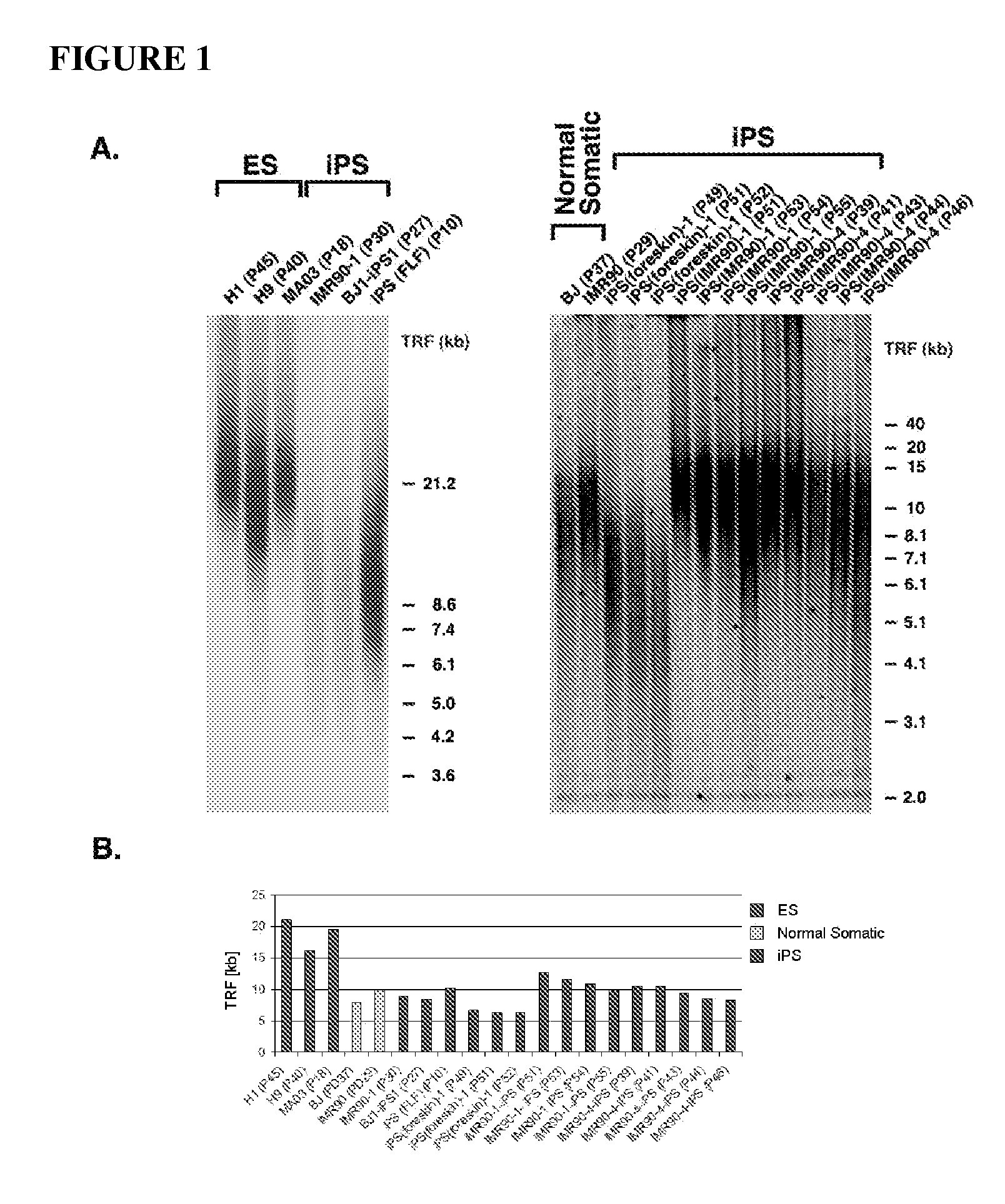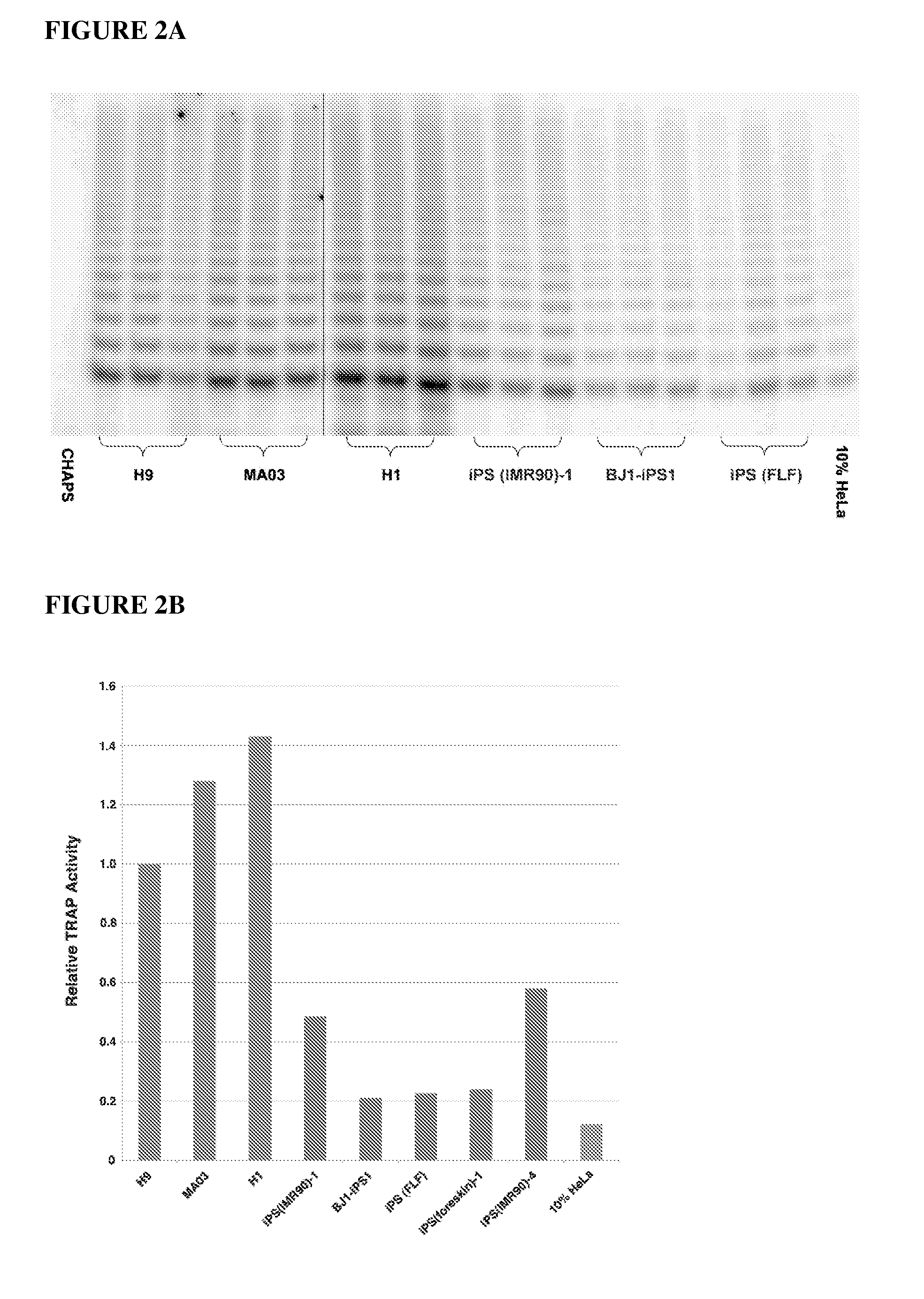Methods for telomere length and genomic DNA quality control and analysis in pluripotent stem cells
a technology of genomic dna quality control and pluripotent stem cells, applied in the field of pluripotent stem cell telomere length and genomic dna quality control and analysis, can solve the problems of little research on the effects of transcriptional reprogramming on cellular aging, the risk of cell malignancy, and the general ceaseance of embryonic developmen
- Summary
- Abstract
- Description
- Claims
- Application Information
AI Technical Summary
Benefits of technology
Problems solved by technology
Method used
Image
Examples
example 1
[0079]Telomere length regulation is important for maintenance of the immortal phenotype of reproductive-lineage cells and for setting the replicative lifespan of mortal somatic cells. While transcriptional reprogramming is capable of reversing the differentiation of somatic cells to induced pluripotent stem cells, such reprogramming may not reverse cellular aging by the restoration of embryonic telomere lengths. Indeed, Feng et al. (Stem Cells, 28(4):704-12) describe that, in contrast to hES cell derivatives, hemangioblasts / blast cells and RPE generated from human iPS cells displayed limited expansion capability and exhibited apoptosis morphology, stating that the underlying molecular mechanisms for these differences remain elusive. We therefore surveyed telomere length in widely-distributed hES and iPS cell lines and observed variable but relatively long TRF lengths in three hES cell lines (16.09-21.1 kb) but markedly shorter TRF lengths (6-10.2 kb) in five iPS cell lines. Transcri...
example 2
[0191]Gene expression analysis was performed on a series of different cell populations / cell lines and the level of VENTX expression was compared (gene expression analysis methods described in Example 1),
[0192]Panel A of FIG. 14 shows relative VENTX expression levels for numerous different human ES (H1, H9, MAG3) and iPS (IMR90-1, BJ1, 44.1, EH3) cell lines that can reset telomeres to embryonic lengths (at specific passages / culture conditions as indicated) as well as the embryonic carcinoma (EC) cell line Recyte P59 and the fetal lung fibroblast line AG04432 at passage 7. As can be seen in Panle A, VENTX expression is relatively high in cell lines having telomere lengths restored to embryonic levels.
[0193]Panel B of FIG. 14 shows that VENTX expression in numerous differentiated mortal cells of many different cell types is at or near background levels, whereas VENTX expression in a variety or human ES and iPS cell lines having telomere lengths restored to embryonic levels is well abov...
example 3
Gene Expression Assays Predicting the Potential for Reprogrammed Cells to Spontaneously Immortalize
[0194]Normal human somatic cells invariably senesce when serially cultivated in vitro (Hayflick L (1965) The limited in vitro lifetime of human diploid cell strains. Exp Cell Res 37:614-636). Exceptions to this rule are undifferentiated human embryonic stem cell lines and iPS cell lines that express telomerase activity (as described herein), abnormal cells that have undergone malignant transformation, or somatic cells in which the catalytic component of telomerase TERT has been exogenously expressed.
[0195]Differentiated clonal embryonic progenitors were derived from the parental iPS cell line EH3 at passage 8 (P8), which was derived from the cell line EN13. As described above, EH3 was show to have restored telomere length (see FIG. 8 and its description above). The method used to derive the clonal embryonic progenitor cell lines was described previously (see US Patent Publication No. 2...
PUM
| Property | Measurement | Unit |
|---|---|---|
| Digital information | aaaaa | aaaaa |
| Digital information | aaaaa | aaaaa |
| Digital information | aaaaa | aaaaa |
Abstract
Description
Claims
Application Information
 Login to View More
Login to View More - R&D
- Intellectual Property
- Life Sciences
- Materials
- Tech Scout
- Unparalleled Data Quality
- Higher Quality Content
- 60% Fewer Hallucinations
Browse by: Latest US Patents, China's latest patents, Technical Efficacy Thesaurus, Application Domain, Technology Topic, Popular Technical Reports.
© 2025 PatSnap. All rights reserved.Legal|Privacy policy|Modern Slavery Act Transparency Statement|Sitemap|About US| Contact US: help@patsnap.com



